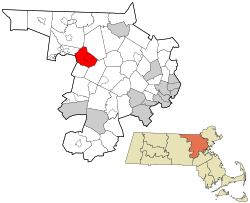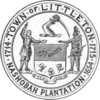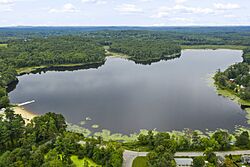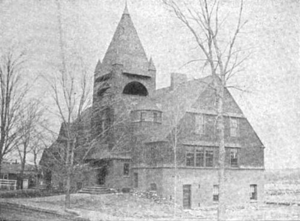Littleton, Massachusetts facts for kids
Quick facts for kids
Littleton, Massachusetts
|
||
|---|---|---|
 |
||
|
||

Location in Middlesex County in Massachusetts
|
||
| Country | United States | |
| State | Massachusetts | |
| County | Middlesex | |
| Settled | 1686 | |
| Incorporated | 1715 | |
| Government | ||
| • Type | Open town meeting | |
| Area | ||
| • Total | 17.6 sq mi (45.5 km2) | |
| • Land | 16.6 sq mi (43.0 km2) | |
| • Water | 0.9 sq mi (2.4 km2) | |
| Elevation | 229 ft (70 m) | |
| Population
(2020)
|
||
| • Total | 10,141 | |
| • Density | 610.9/sq mi (235.8/km2) | |
| Time zone | UTC−5 (Eastern) | |
| • Summer (DST) | UTC−4 (Eastern) | |
| ZIP Code |
01460
|
|
| Area code(s) | 351/978 | |
| FIPS code | 25-35950 | |
| GNIS feature ID | 0619403 | |
| Website | www.littletonma.org | |
Littleton is a town in Middlesex County, Massachusetts, United States. It was once known as Nashoba. In 2020, about 10,141 people lived there.
Contents
History of Littleton
Early Days: 17th Century
Littleton was first home to Native Americans. In 1645, it became the sixth "Praying Indian" village. These were villages where Native Americans had become Christians. It was called Nashoba Plantation. This area was between Lake Nagog and Fort Pond.
During King Philip's War, a conflict between English settlers and Native Americans, the Nashoba people faced hard times. Many were forced to move to Deer Island. There, many died from hunger and sickness. Later, some Native Americans became scouts for the English. This helped change how white settlers felt about them. After the war, most survivors sold their land and moved away.
English settlers officially started the town in 1686. It became an official town on November 2, 1715. It was part of the Puritan culture of New England.
The town's name, Littleton, might have come from a compliment to Hon. George Lyttleton, a British official. It's said he sent a church bell as a gift. But because the town's name was spelled with an "i" instead of a "y," the bell was supposedly held back and sold.
Growth and Change: 18th Century
The few Native American survivors found it hard to rebuild their village. English settlers bought land from them. The new community grew and became a town in 1714. Its borders included what is now Boxborough. The town's meetinghouse, a central building for gatherings, moved in 1717. Sarah Doublet, the last "Praying Indian" from Nashoba, passed away in 1736.
New towns formed nearby. Westford became a town in 1729. Harvard formed in 1732. Acton became a town in 1735.
Littleton had several taverns, which were like inns. These were important gathering places. One was the Long Store, built around 1700. Another was the Fox Tavern, also built around 1700. The Lawrence Tavern was built in 1768.
In 1742, a new meetinghouse was built. It cost £900. This was the only church in town for the rest of the 1700s. Warren's Grist Mill, which processed crops, started being built in 1750.
Littleton residents joined the militia to protect against Native Americans and the French. These groups later became the ones who fought the British on April 18, 1775.
Littleton's minutemen and militia fought in the Battle of Concord on April 19, 1775. They gathered at Liberty Square and marched to the Old North Bridge.
In 1783, Boxborough officially became a separate town. This took away almost a quarter of Littleton's land.
In 1795, Littleton built its first public schools. These included the North, East, South, and West School Houses. They served children until 1870.
Local stories say that some people in Littleton remained loyal to the British after the American Revolution. They supposedly stopped attempts to rename King Street. This led to other towns calling Littleton a "Tory town."
Industrial Changes: 19th Century
Littleton grew slowly in the 1800s. It became known for its apple orchards and the cider it produced. Warren's Gristmill later became a sawmill.
In 1822, Baptists in town built their own church. This happened as Unitarianism became popular in New England.
The lyceum movement came to Littleton in 1829. This movement aimed to spread education, especially in science. The Littleton Lyceum held lectures and debates for almost a century. Even during the Civil War, it continued. Veterans would lecture about their experiences.
In 1840, the community had religious disagreements. The Unitarians, who were part of the main meetinghouse, built a larger building. The Orthodox Congregational Society also built their own church in 1841. Both churches are still on Foster and King Streets today.
The Industrial Revolution reached Littleton with the Fitchburg Railroad in 1844. The first train station was built in 1845. A new station was built in 1879 and used until 1970. This train line helped the town grow. Commuter service to Boston started in the 1880s.
Another railroad, the Stony Brook Railroad, also served Littleton. It had a station in North Littleton. Farmers used the railroads to send their crops to markets in Boston. Littleton became famous for its apple orchards.
Movements like Abolitionism (ending slavery) and Transcendentalism (a philosophy about nature and self-reliance) were popular in Littleton. Many discussions happened at the Littleton Lyceum. Several Littleton men fought in the American Civil War. They are remembered on a plaque at the Houghton Memorial Building.
More stores and businesses grew around the Common and the Depot (train station area). The Conant Houghton Co. Mill was built in 1880. It first processed apple products. Later, it made clothing and military equipment. In 1885, a special station for animals moved to Littleton. This made Littleton a center for horse-dealing.
In 1894-95, the Houghton Memorial Building was built for the town library. It was a gift from Elizabeth and Clement S. Houghton. The library was named the Reuben Hoar Library.
Modern Times: 20th and 21st Centuries
Littleton continued to grow in the 1900s. Before World War I, the mill at the Common started making military supplies. Many people moved to town to work there. Young men from Littleton also served in the war. When they returned, they started two veterans' groups.
With cars becoming popular, farming businesses expanded. Dairy farms grew larger. Cloverdale Farm/Dell Dale Farm was a well-known local dairy until 1986. Herpy's Dairy also thrived. Herpy built two large swimming pools at his plant. Over a thousand children learned to swim there each year until it closed in 1968.
Truck farms also appeared along roads like Route 119/2A. These farms grew produce on a large scale to sell in Boston. Trucks would buy produce from farms along the roads. Many farms also sold their goods at roadside stands. These farms were run by both older residents and newer families from different backgrounds.
Arthur Rowse moved his company, New England Vinegar Works, to Littleton in 1930. He wanted to be closer to Massachusetts' apple orchards. His company made the Veryfine brand of apple juice. He famously refused to do business with people involved in illegal alcohol sales during Prohibition.
Littleton was a "dry" town during Prohibition. Even after Prohibition ended in 1933, Littleton did not allow alcohol sales until 1960. Even then, it was only in two places. Bars were not allowed until the late 1980s. Residents often went to nearby towns to buy alcohol.
Littleton has mostly been a town with a strong Yankee character. Many people belonged to the Congregational, Baptist, and Unitarian churches. After World War II, more Roman Catholic immigrants moved to Littleton. St. Anne's Catholic Church was built in 1947. It is now the largest church in town. The Church of Jesus Christ of Latter-day Saints built a chapel in 1979.
Many old family names like Blanchard and Hartwell still have descendants in town. Many summer cottages around Mill Pond have become year-round homes. In the 1950s and 1960s, many families moved to Littleton from bigger cities.
Littleton has been a popular place for military retirees since the 1960s. This is because it is located between Fort Devens and Hanscom AFB.
Author John Hanson Mitchell wrote a book called Ceremonial Time (1984). It tells the history of one square mile in Littleton over fifteen thousand years.
In the 1970s, Digital Equipment Corporation (DEC) came to Littleton. This connected the town to other high-tech businesses in the Boston area. DEC built a large facility on King Street.
In 2007, IBM bought the King Street facility from Hewlett-Packard. IBM announced it would be its main New England location.
In 2014, Littleton celebrated its 300th anniversary.
In 2022, the Littleton mill was reported to have the highest number of federally-licensed firearms dealers in the United States.
Geography
Littleton covers about 17.5 square miles (45.5 square kilometers). Most of this is land, with about 0.9 square miles (2.4 square kilometers) of water.
Littleton shares borders with several other towns. These include Groton, Westford, Acton, Boxborough, Harvard, and Ayer.
 |
Groton & Ayer | Groton | Westford |  |
| Harvard | Acton | |||
| Boxborough | Acton & Boxborough | Acton |
People and Population
| Historical population | ||
|---|---|---|
| Year | Pop. | ±% |
| 1850 | 987 | — |
| 1860 | 1,063 | +7.7% |
| 1870 | 986 | −7.2% |
| 1880 | 994 | +0.8% |
| 1890 | 1,025 | +3.1% |
| 1900 | 1,179 | +15.0% |
| 1910 | 1,229 | +4.2% |
| 1920 | 1,277 | +3.9% |
| 1930 | 1,447 | +13.3% |
| 1940 | 1,651 | +14.1% |
| 1950 | 2,349 | +42.3% |
| 1960 | 5,109 | +117.5% |
| 1970 | 6,380 | +24.9% |
| 1980 | 6,970 | +9.2% |
| 1990 | 7,051 | +1.2% |
| 2000 | 8,184 | +16.1% |
| 2010 | 8,924 | +9.0% |
| 2020 | 10,141 | +13.6% |
| 2023* | 10,251 | +1.1% |
| * = population estimate. | ||
In 2020, Littleton had 10,141 people living in 3,657 households. About 23.2% of households had children under 18. Most households (64.0%) were married couples. The average household had 2.72 people.
The population was 80.71% White, 1.34% African American, and 8.17% Asian. About 3.25% of the population was Hispanic or Latino.
The median age in Littleton was 44.7 years. About 23.2% of the people were under 18. About 15.3% were 65 or older.
The average household income was $123,413. The average family income was $143,233. Only a small number of families (2.4%) lived below the poverty line.
Education
Littleton Public Schools
- Littleton High School
- Littleton Middle School (new building in 2006)
- Russell Street Elementary
- Shaker Lane Elementary
Other Public Schools Nearby
- Nashoba Valley Technical High School: A public high school in Westford for technical skills.
- Francis W. Parker Charter Essential School: A public charter school in Devens for grades 7 to 12.
Local Private Schools
- Academy of Notre Dame: A Catholic school in Tyngsborough for K1 through 12th grade.
- Applewild School: A private school in Fitchburg for preschool to 8th grade.
- Concord Academy: A private high school in Concord for grades 9 to 12.
- Country Day School of the Holy Union: A Catholic school in Groton for Pre-K to 8th grade.
- The Fenn School: An all-boys private school in Concord for grades 4 to 9.
- Groton School: A private boarding school in Groton for grades 9 to 12.
- Lawrence Academy at Groton: A private school in Groton for grades 9 to 12.
- Middlesex School: A private school in Concord for grades 9 to 12.
- Nashoba Brooks School: A private school for Pre-K to 8th grade.
- Oak Meadow School: A private Montessori school in Littleton for Pre-K to 8th grade.
Library Services
The public Reuben Hoar Library first opened in 1887. In 1895, it moved into the Houghton Memorial Building. The library, still named after Reuben Hoar, moved to 41 Shattuck Street in 1991. The Houghton Memorial Building then became home to the Littleton Historical Society. In November 2021, the Reuben Hoar Library moved to 35 Shattuck Street.
Media and Local Organizations
Local Media
The local newspaper is called the Littleton Independent. Littleton Community Television (LCTV) has a studio at 37 Shattuck Street.
Community Groups
Littleton has many local groups that help the town. These include the Littleton Conservation Trust, which protects nature. The Littleton Country Gardeners and the Littleton Historical Society also contribute to the community.
The Littleton Lyceum and the Indian Hill Music Center are cultural organizations. The Littleton Rotary Club helps with community projects. Other groups like the Masonic Lodge and Knights of Columbus are also active.
Charity groups like the Loaves and Fishes Food Pantry help those in need. Local veterans have two posts: American Legion Post 249 and Veterans of Foreign Wars Post 6556.
Places of Worship
Littleton, like many old New England towns, grew around its churches. After the Nashoba village, English settlers built their first meetinghouse in 1715. This is now the site of the First Church Unitarian.
The First Baptist Church Littleton was built in 1822. In 1841, another group built the Congregational Church of Littleton. These Protestant churches were the only ones in town for a long time.
In the 20th century, more Roman Catholic immigrants moved to Littleton. The first Catholic Mass was held in Littleton Town Hall in 1911. St. Anne's Catholic Church was established in 1916. It became its own parish in 1945. The current church building was built in 1960.
During the Cold War, more Mormons moved to the area. The Littleton Ward of The Church of Jesus Christ of Latter-day Saints was built in the 1980s.
The Greater Littleton Interfaith Council works together on charity and faith activities. Other religions in Littleton are served by places of worship in nearby towns.
Transportation
You can travel to Littleton by train from Boston's North Station. The MBTA provides commuter rail service with a stop in Littleton on its Fitchburg Line. The LRTA 15 bus line also serves the area.
Freight trains travel daily through Littleton. The tracks are part of the historic Stony Brook Railroad. This line is important for connecting New Hampshire and Maine with other states.
Major roads in Littleton include I-495, Route 2, Route 2A, Route 110, and Route 119.
Notable People
- Shawn Andrews, an actor.
- Ron Borges, a sports writer.
- Steve Carell, worked as a mail carrier in town before becoming a famous actor.
- Levi L. Conant, a mathematician.
- Margaret Harwood, an astronomer.
- Greg Hawkes, keyboard player for the band The Cars.
- John Hanson Mitchell, an author.
- Harrison Reed, a former governor of Florida.
Images for kids
See also
 In Spanish: Littleton (Massachusetts) para niños
In Spanish: Littleton (Massachusetts) para niños











